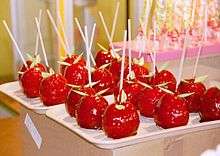Candy apple
 | |
| Alternative names | Toffee apple |
|---|---|
| Type | Confectionery |
| Place of origin | United States |
| Created by | William W. Kolb |
| Main ingredients | Apples, toffee or sugar candy |
|
| |
Toffee apples, also known as candy apples in North America, are whole apples covered in a hard toffee or sugar candy coating, with a stick inserted as a handle. These are a common treat at autumn festivals in Western culture in the Northern Hemisphere, such as Halloween and Guy Fawkes Night because these festivals fall in the wake of the annual apple harvest.[1] Although candy apples and caramel apples may seem similar, they are made using distinctly different processes.
History
According to one source, American William W. Kolb invented the red candy apple.
Kolb, a veteran Newark candy-maker, produced his first batch of candied apples in 1908. While experimenting in his candy shop with red cinnamon candy for the Christmas trade, he dipped some apples into the mixture and put them in the windows for display. He sold the whole first batch for 5 cents each and later sold thousands yearly. Soon candied apples were being sold along the Jersey Shore, at the circus and in candy shops across the country, according to the Newark News in 1948.[2]
Ingredients and method
Candy apples are made by coating an apple with a layer of sugar that has been heated to hard crack stage (depending upon the type of sugar).[3] The most common sugar coating is made from sugar (white or brown), corn syrup, water, cinnamon and red food coloring. Humid weather can prevent the sugar from hardening.[4]
Regional traditions
- Australia - the Granny Smith variety of apple is considered ideal for creating the children's treat.[5]
- Brazil - candy apples (named as in other Lusophone countries maçã-do-amor, as in the French pommes d'amour, meaning "apples of love") are common in the festivities in honour of John the Apostle.
- China - a similar treat called Tanghulu is made by coating small fruits, traditionally hawthorns with hard sugar syrup.
- Canada - very popular and usually eaten at fairs or carnivals.
- France - candy apples are called pommes d'amour (Apples of love). They are a common treat found at many festivals in France.
- Germany - most often associated with the Christmas season. They are also sometimes sold at carnivals and fairs
- Israel - almost solely sold in cities' squares on Yom Ha'atzmaut eve (Israel Independence Day) as part of the street celebrations.
- Japan - candy apples, grapes, strawberries and tangerines are commonly available at Japanese festivals.[6]
- Republic of Ireland - eaten at Halloween.
- United Kingdom - associated with and eaten at Halloween (Scotland and Northern Ireland), Bonfire Night (England).
- United States - jelly apples, found in New York's Coney Island area, are related but have a soft candy ("jelly") coating and a cherry flavor, not cinnamon.
Cultural references

Urban myths
During the 1960s and 1970s, news reports about children supposedly receiving candy apples with pins and razor blades in them, created hysteria during Halloween in the United States. During the hysteria, hospitals offered free x-rays to detect foreign objects in the candy apples. To date, the stories have never been substantiated and fall into the category of urban legend.[7]
See also
| Wikimedia Commons has media related to Candy apples. |
References
- ↑ ThisisSouthDevon (October 9, 2008). "Apples galore as event grows". Torquay Herald Express. Torquay, Devon, UK: localworld.co.uk. Retrieved November 17, 2013.
- ↑ Newark Sunday News, November 28, 1948, pg.16. Newark Evening News, June 8, 1964, pg. 32
- ↑ Flickety; et al. "How to make Toffee Apples". WikiHow. Retrieved February 17, 2014.
- ↑ "Caramel Apples vs. Candy Apples". St. Petersburg Times. October 24, 2001. Retrieved October 22, 2010.
- ↑ "Designer Toffee Apples". Designer Toffee Apples. Retrieved February 17, 2014.
- ↑ Celeste Heiter; Things Asian Press (November 1, 2009). To Japan with Love: A Travel Guide for the Connoisseur. ThingsAsian Press. pp. 127–. ISBN 978-1-934159-05-7. Retrieved November 11, 2011.
- ↑ "The History of Halloween". The History of Halloween. Retrieved October 22, 2010.
